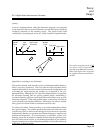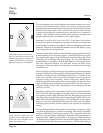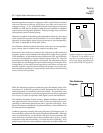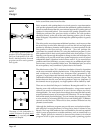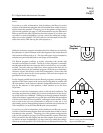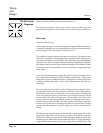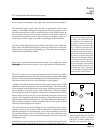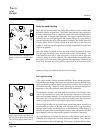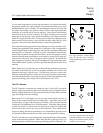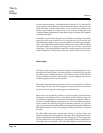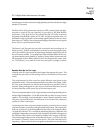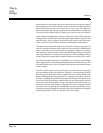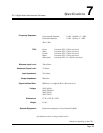
Page 47
CP-1 Digital Audio Environment Processor
Pro Logic decoders remove dialog
from the left and right channels,
while maintaining stereo as much as
possible.
Pro Logic requires phase accuracy.
Common azimuth errors cause ghost
dialog in all channels unless the azi-
muth error is corrected.
Theory
and
Design
is even more important in a home decoder than in a professional model,
because the small size of the playback room makes decoding errors more
audible than they are in a theater. The level detection must be very fast, and
the matrix must adapt very quickly or there will be a time lag between the
audibility of a sound and its correct steering. Since phase relationships
determine how the sound is steered, Pro Logic decoding puts unusual
demands on the accuracy of the phase and balance of the input channels.
Other Pro-Logic decoders have a front panel control for adjusting input
balance and for best results a user should carefully adjust this for each
program. But what if the channel balance varies during playback?
The manual balancing procedure does nothing to correct azimuth errors.
During the preparation of the master for a video tape or disc, misalignment
of the playback heads or skewing of the film produce small time differences
between the two channels. Azimuth is poorly controlled in both profes-
sional video recorders and optical film chains. In the final product, which
has been through many generations, it can easily be wrong by 50 microsec-
onds or more, and may vary as the tape or disk is played. At middle and
high frequencies it doesn’t take much misalignment to generate large inter-
channel differences in phase, which are just what the decoder uses to do its
steering.
Other Dolby Pro Logic decoders try to deal with this problem by reducing
the treble in the surround, so the out-of-phase sibilants in the film do not
splatter annoyingly from the rear. This does not, however, reduce the
sibilants in the side speakers. Some non-Pro Logic decoders reduce these
side-channel sibilants by narrowing the spread of the front channels in the
presence of dialog; this compromise is unnecessary in the CP-1.
The CP-1 Decoder
The CP-1 decoder is unusual in a number of ways. First of all, it is entirely
digital. (Most surround decoders advertise that they are digital because
there is a digital delay line for the surround channel but the matrix and the
logic decoding are done in analog.)
Because the CP-1 is all digital, we can use some of the digital memory to
delay all the output channels by 20 milliseconds — about the same as the
acoustic delay you get in the front row of a theater. (The surround channel
is delayed by an additional 16 to 32 milliseconds.) This delay allows plenty
of time for the CP-1 to determine the direction of sounds and adjust the
matrix before the sounds are sent to the amplifiers. This substantially
improves dialog and effects cancellation, as is immediately apparent from
the spread of ambient material or music, even in the presence of dialog.
The CP-1 can also sense and continuously correct both balance and azimuth
errors in the incoming material. All the time the film is playing, the CP-1 is
checking balance and azimuth, keeping the dialog perfectly centered. The



